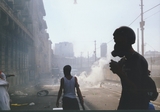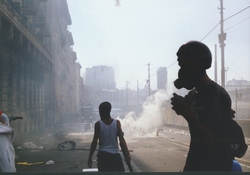
2007-03-14
Carlo Giuliani was shot and killed by a carabinieri (Italian policeman) whilst he was taking part in an anti-globalisation demonstration in connection with the G8 summit held in Genoa in 2001.
His family complained to the European Court of Human Rights; relying on Article 2 (right to life) of the European Convention on Human Rights, that Carlo’s death was caused by excessive use of force and that the organisation of the operations to maintain and restore public order was inadequate.
European Court Of Human Rights – Admissibility Decision Giuliani V. Italy
Press release issued by the Registrar 12.3.2007

A Chamber of the European Court of Human Rights has declared admissible the application lodged in the case of Giuliani v. Italy (application no. 23458/02) (The decision is available only in French.)
The decision is available today on the Court’s Internet site ( http://www.echr.coe.int). Judgment will be delivered at a later date.
The applicants
Giuliano Giuliani, his wife Adelaide Gaggio and their daughter Elena Giuliani are Italian nationals who were born in 1938, 1944 and 1972 respectively and live in Genoa and Milan (Italy).
Summary of the facts 1
The application concerns the death of the applicants’ son and brother, 23-year-old Carlo Giuliani, which occurred while he was taking part in an anti-globalisation demonstration in connection with the G8 summit held in Genoa in 2001.
In the context of the G8 summit held in Genoa, from 19 to 21 July 2001, numerous anti- globalisation demonstrations were held in the city and substantial security arrangements were put in place by the Italian authorities, including deployment of the armed forces.
On 20 July an authorised demonstration involving large numbers of participants gave rise to violent clashes between demonstrators and the security forces. At around 5 p.m. a group of about 50 carabinieri withdrew in disorderly fashion near Piazza Alimonda, with the result that two jeeps which had been bringing up the rear were left isolated.
Following a driver error, one of the vehicles, with three carabinieri inside, remained on Piazza Alimonda, unable to move. Objects, mainly stones, were then thrown at the jeep and some demonstrators ran towards it. One of the carabinieri, panicking, seized his weapon, which he pointed outside the vehicle, shouted to the crowd to leave and then fired two shots. Carlo, who had just picked up a fire extinguisher, was a few metres away from the jeep; the first bullet hit him just below the eye and he fell to the ground. In an attempt to move the jeep out, the driver reversed over Carlo’s body; he then engaged first gear and drove over him again. When the demonstrators had been dispersed, a doctor arrived at the scene and pronounced Carlo dead.
An investigation was opened immediately by the Italian authorities, in the course of which statements were taken from the three carabinieri in the jeep and evidence was heard from other carabinieri and from some of the demonstrators. Criminal proceedings were instituted against the officer who had fired the shots and the driver of the jeep for intentional homicide. The autopsy performed on Carlo’s body within 24 hours of his death revealed that the bullet impact to his head had been sufficient to cause death within a few minutes, whereas the jeep’s driving over his body had resulted only in minor injuries. The forensic expert found that the shot had been fired at a downward angle.
At the public prosecutor’s request three expert reports were prepared; the authors of the third report, submitted in June 2002, first deplored the fact that they had been unable to examine Carlo’s body. They concluded that the bullet had been fired upwards by the officer but had been deflected by a stone thrown at the jeep by another demonstrator, with the result that it had struck Carlo. In their estimation, Carlo had been about 1.75 metres from the jeep when the shot had been fired, and the officer firing the shot had therefore been able to see him.
On 5 May 2003 the investigating judge discontinued the proceedings. She held that the driver of the jeep, whose actions had resulted only in bruising, could not be held responsible for the killing as he had been unable to see Carlo, given the confusion prevailing around the vehicle. As to the officer who had fired the fatal shot, the judge took the view that he had fired into the air but that the bullet had been deflected by a stone, causing it to strike Carlo. In the judge’s view, the carabiniere had made legitimate use of his weapon and had acted in self defence in response to a violent attack on the jeep.
Complaints
Relying on Article 2 (right to life) of the European Convention on Human Rights, the applicants allege that Carlo’s death was caused by excessive use of force and that the organisation of the operations to maintain and restore public order was inadequate. In addition, they argue that the failure to lend immediate assistance to Carlo amounts to a violation of Articles 2 and 3 (prohibition of inhuman treatment).
The applicants further complain that there was no effective investigation, particularly as no evidence was taken from certain witnesses or from the senior police officers concerned. They also contend that one of the experts appointed by the public prosecutor’s office, the person who put forward the theory of the bullet having been “deflected by a stone”, published an article shortly before his appointment in which he supported the self-defence argument. Finally, despite the fact that the investigation concerned two carabinieri, several investigative measures were entrusted to the carabinieri. The applicants rely on Articles 2, 6 (right to a fair hearing) and 13 (right to an effective remedy).
Procedure
The application was lodged with the European Court of Human Rights on 18 June 2002. A hearing took place in public in the Human Rights Building, Strasbourg, on 5 December 2006.
Press contacts
Emma Hellyer (telephone: 00 33 (0)3 90 21 42 15)
Stéphanie Klein (telephone: 00 33 (0)3 88 41 21 54)
Beverley Jacobs (telephone: 00 33 (0)3 90 21 54 21)
The European Court of Human Rights was set up in Strasbourg by the Council of Europe Member States in 1959 to deal with alleged violations of the 1950 European Convention on Human Rights.
1 This summary by the Registry does not bind the Court.
[http://www.indymedia.org.uk/en/2007/03/364998.html]

